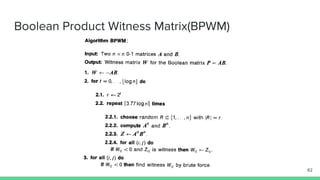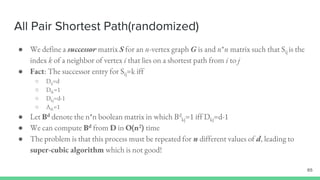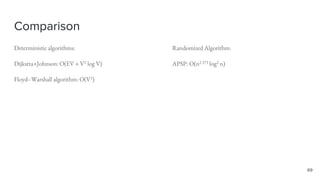Randomized algorithms all pairs shortest path
- 1. Randomized Algorithms: All Pairs Shortest Path Instructor: Dr. S. N. Hashemi Lecturer: Mohammad Akbarizadeh m.akbarizadeh@aut.ac.ir
- 2. Outline ● Deterministic Algorithms ○ Single Source Shortest Path ■ Dijkstra ■ Bellman-Ford ○ All Pairs Shortest path ■ Floyd-Warshall ● Randomized Algorithm ○ All Pair Distance problem ○ Boolean Product Witness Matrix ○ All Pair Shortest Path ● Comparison 2
- 3. Deterministic Algorithms Single Source Shortest Path
- 4. Question Q: How to solve the single source shortest path problem if the given graph is unweighted? What is the time complexity? 4
- 5. Question Q: How to solve the single source shortest path problem if the given graph is unweighted? What is the time complexity? A: We can easily apply BFS to the graph and solve it in O(V+E) 5
- 6. Dijkstra Algorithm ● Given a graph and a source vertex, find shortest paths from source to all vertices in the given graph ● Dijkstra is a greedy algorithm for finding the shortest path from a node which ends in having a tree with the lowest total cost (similar algorithms: Prim, Kruskal) ● It can be applied to both directed and undirected graph ● Dijkstra doesn’t work for Graphs with negative weight edges ● Time complexity: O(V2) 6
- 8. Dijkstra (example) Graph = {(0,1)=4, (0,7)=8, (1,2)=8, (1,7)=11, (7,8)=7, (7,6)=1, (2,3)=7, (2,5)=4, (2,8)=2, (8,6)=6, (6,5)=2, (3,4)=9, (3,5)=14, (5,4)=10} Distance = {INF, INF, INF, INF, INF, INF, INF, INF, INF} Prev = {UND, UND, UND, UND, UND, UND, UND, UND, UND} Q = {0, 1, 2, 3, 4, 5, 6, 7, 8} 8
- 9. Dijkstra (example) Graph = {(0,1)=4, (0,7)=8, (1,2)=8, (1,7)=11, (7,8)=7, (7,6)=1, (2,3)=7, (2,5)=4, (2,8)=2, (8,6)=6, (6,5)=2, (3,4)=9, (3,5)=14, (5,4)=10} Distance = {0, 4, INF, INF, INF, INF, INF, 8, INF} Prev = {UND, 0, UND, UND, UND, UND, UND, 0, UND} Q = {1, 2, 3, 4, 5, 6, 7, 8} 9
- 10. Dijkstra (example) Graph = {(0,1)=4, (0,7)=8, (1,2)=8, (1,7)=11, (7,8)=7, (7,6)=1, (2,3)=7, (2,5)=4, (2,8)=2, (8,6)=6, (6,5)=2, (3,4)=9, (3,5)=14, (5,4)=10} Distance = {0, 4, 12, INF, INF, INF, INF, 8, INF} Prev = {UND, 0, 1, UND, UND, UND, UND, 0, UND} Q = {2, 3, 4, 5, 6, 7, 8} 10
- 11. Dijkstra (example) Graph = {(0,1)=4, (0,7)=8, (1,2)=8, (1,7)=11, (7,8)=7, (7,6)=1, (2,3)=7, (2,5)=4, (2,8)=2, (8,6)=6, (6,5)=2, (3,4)=9, (3,5)=14, (5,4)=10} Distance = {0, 4, 12, INF, INF, INF, 9, 8, 15} Prev = {UND, 0, 1, UND, UND, UND, 7, 0, 7} Q = {2, 3, 4, 5, 6, 8} 11
- 12. Dijkstra (example) Graph = {(0,1)=4, (0,7)=8, (1,2)=8, (1,7)=11, (7,8)=7, (7,6)=1, (2,3)=7, (2,5)=4, (2,8)=2, (8,6)=6, (6,5)=2, (3,4)=9, (3,5)=14, (5,4)=10} Distance = {0, 4, 12, INF, INF, 11, 9, 8, 15} Prev = {UND, 0, 1, UND, UND, 6, 7, 0, 6} Q = {2, 3, 4, 5, 8} 12
- 13. Dijkstra (example) Graph = {(0,1)=4, (0,7)=8, (1,2)=8, (1,7)=11, (7,8)=7, (7,6)=1, (2,3)=7, (2,5)=4, (2,8)=2, (8,6)=6, (6,5)=2, (3,4)=9, (3,5)=14, (5,4)=10} Distance = {0, 4, 12, 19, 21, 11, 9, 8, 14} Prev = {UND, 0, 1, 2, 5, 6, 7, 0, 2} Q = {} 13
- 14. Dijkstra (Question) Q: What if one of the weights was zero? 14
- 15. Dijkstra (Question) Q: What if one of the weights was zero? A: No problem for Dijkstra algorithm. The answer will be correct if we run dijkstra on the graph but we can merge two nodes can be merged 15
- 16. Dijkstra (Question) Q: What if one of the weights was zero? A: No problem for Dijkstra algorithm. The answer will be correct if we run dijkstra on the graph but we can merge two nodes can be merged Q: What if the graph is not connected? What happens to the weights? 16
- 17. Dijkstra (Question) Q: What if one of the weights was zero? A: No problem for Dijkstra algorithm. The answer will be correct if we run dijkstra on the graph but we can merge two nodes can be merged Q: What if the graph is not connected? What happens to the weights? A: Nodes that are not reachable from the source will have INF value and the algorithm will not proceed 17
- 18. Bellman-Ford Algorithm ● Given a graph and a source vertex src in graph, find shortest paths from src to all vertices in the given graph. ● This algorithm works with graphs having negative weight edges ● Greedy algorithm but simpler than Dijkstra and uses relaxation like Dijkstra ● It relaxes all the edges at most |V|-1 times until it finds the answer (no change happens after update) ● Time complexity: O(VE) 18
- 20. Bellman-Ford Algorithm (example) 20 G = { (A,B)=-1, (A,C)=4, (B,C)=3, (D,C)=5, (B,D)=2, (D,B)=1, (B,E)=2, (E,D)=-3 } S = A Process order: (B, E), (D, B), (B, D), (A, B), (A, C), (D, C), (B, C), (E, D)
- 21. Bellman-Ford Algorithm (example) 21 G = { (A,B)=-1, (A,C)=4, (B,C)=3, (D,C)=5, (B,D)=2, (D,B)=1, (B,E)=2, (E,D)=-3 } S = A Process order: (B, E), (D, B), (B, D), (A, B), (A, C), (D, C), (B, C), (E, D)
- 22. Bellman-Ford Algorithm (example) 22 G = { (A,B)=-1, (A,C)=4, (B,C)=3, (D,C)=5, (B,D)=2, (D,B)=1, (B,E)=2, (E,D)=-3 } S = A Process order: (B, E), (D, B), (B, D), (A, B), (A, C), (D, C), (B, C), (E, D)
- 23. Bellman-Ford Algorithm (Question) 23 Q = What happens if (B,D)=-2 and (D,B)=-1 ?
- 24. Bellman-Ford Algorithm (Question) 24 Q = What happens if (B,D)=-2 and (D,B)=-1 ? A = The algorithm gets stuck in a loop and updates the weights until it reaches the end of the algorithm (Algorithm won't work in this situation) Process order: (B, E), (D, B), (B, D), (A, B), (A, C), (D, C), (B, C), (E, D)
- 25. Bellman-Ford Algorithm (Question) 25 Q = When does the worst case scenario happens? What is the worst case scenario for this algorithm?
- 26. Bellman-Ford Algorithm (Question) 26 Q = When does the worst case scenario happens? What is the worst case scenario for this algorithm? A = When we a complete graph like K5 we will have V(V-1)/2 edges which have to processed V times, which has O(V3) time complexity
- 27. Deterministic Algorithms All Pairs Shortest Path
- 28. Floyd-Warshall Algorithm ● Given a graph, finds the shortest paths from all vertices to all other vertices ● Uses Dynamic Programming to solve the problem ● Edge weights can be negative (but no negative cycles) and graph can be directed ● Time complexity: O(V3) 28
- 35. Floyd-Warshall Algorithm (another example) 35
- 36. Floyd-Warshall Algorithm (another example) 36
- 37. Floyd-Warshall Algorithm (another example) 37
- 38. Floyd-Warshall Algorithm (another example) 38
- 39. Floyd-Warshall Algorithm (another example) 39
- 41. Randomized Algorithm ● A Las Vegas algorithm is a randomized algorithm that always gives the correct result but gambles with resources. ● Monte Carlo simulations are a broad class of algorithms that use repeated random sampling to obtain numerical results. ○ Monte Carlo simulations are typically used to simulate the behaviour of other systems. ○ Monte Carlo algorithms, on the other hand, are randomized algorithms whose output may be incorrect with a certain, typically small, probability. 41
- 42. How to solve APSP problem using Randomized algorithms? ● We will show that the problem of computing all-pairs shortest path is reducible, via a randomized reduction, to the problem of multiplying two integer matrices ● First we solve the easier version of problem for unweighted graph and then get to solve the weighted graph 42
- 43. Randomized Algorithm All Pair Distance Problem
- 44. All Pair Distance problem( APD problem) ● Given an unweighted graph G and its adjacency matrix A, compute the distance matrix D ● Let G’(V,E’) be a graph obtained from G(V,E) by placing an edge between every pair of vertices i≠j ∊V that are at distance 1 or 2 in G ● The graph G is a subgraph of G’, and we could view G’ as the square of the graph G ● Lemma 1: If we compute Z=A2, then there is path of length 2 in G between pair of vertices i and j if and only if Zij>0. Further, the value of Zij indicates the number of distinct length 2 paths between i and j ● If we compute Z=A3, we can obtain if there is a path of length 3 between i and j in G if and only if Zij>0 44
- 45. All Pair Distance problem( APD problem) 45 G = {(1,2), (2,3), (2,4), (3,4)}
- 46. All Pair Distance problem( APD problem) 46 G = {(1,2), (2,3), (2,4), (3,4)} A = [[ 0, 1, 0, 0], [ 1, 0, 1, 1], [0, 1, 0, 1], [0, 1, 1, 0]]
- 47. All Pair Distance problem( APD problem) 47 G = {(1,2), (2,3), (2,4), (3,4)} A = [[ 0, 1, 0, 0], [ 1, 0, 1, 1], [0, 1, 0, 1], [0, 1, 1, 0]] A2= [[1, 0, 1, 1], [0, 3, 1, 1], [1, 1, 2, 1], [1, 1, 1, 2]]
- 48. All Pair Distance problem( APD problem) ● If given graph G with adjacency matrix A and distance matrix D and we compute Z=G2 with adjacency matrix A’ and distance matrix D’ ● To ensure A’ has a zero diagonal, we compute it by setting A’ ij=1 if and only if i≠j and at least one of A’ ij or Aij is non-zero ● We can observe G’ is complete if and only if G has diameter at most 2, where diameter of a graph is the maximum shortest path length over all pairs of vertices ● is there any way we could compute D’ from D? 48
- 49. All Pair Distance problem( APD problem) ● Observation: if G has a diameter at most 2, then G’ is complete and in D=2A’-A ● This can be obtained from A and A’ in time O(n2) ● Lemma 2: consider any pair of vertices i,j ∊V ○ If Dij is even then Dij=2D’ ij ○ If Dij is odd then Dij=2D’ ij - 1 ● By using this lemma we can recursively compute distance matrix of graph G from distance matrix of graph G’ ● But how can we compute the parities of the shortest path lengths? 49
- 50. All Pair Distance problem( APD problem) ● Lemma 3: consider any pair of distinct vertices i and j in G ○ For any neighbor k of i, Dij- 1 ≤ Dkj ≤ Dij+ 1 ○ There exists a neighbor k of i such that Dkj = Dij - 1 ● Now using this lemma we can have a structural property to compute the parities of the shortest path lengths ● Lemma 4: consider any pair of distinct vertices i and j in G: ○ If Dij is even, then D’ kj ≥ D’ ij for every neighbor k of i in G ○ If Dij is odd, then D’ kj ≤ D’ ij for every neighbor k of i in G. moreover, there exists a neighbor k of i in G such that D’ kj < D’ ij 50
- 51. All Pair Distance problem( APD problem) ● Let Γ(i) denote the set of neighbors of i in G and d(i) be the degree of i. Note that A’ ii=d(i) ● By summing the inequalities in lemma 4 over the neighbors of vertex i we can obtain the following result: ● Lemma 5: consider any pair of distinct vertices i and j in G: ○ Dij is even if and only if ∑k∊Γ(i) D’ kj ≥ D’ ijd(i) ○ Dij is odd if and only if ∑k∊Γ(i) D’ kj < D’ ijd(i) ● In this lemma matrix multiplication is used to compute: ○ ∑k∊Γ(i) D’ kj= ∑n k=1 Aik D’ kj = Sij 51
- 52. All Pair Distance problem( APD problem) 52
- 53. All Pair Distance problem( APD problem) 53 ● The APD algorithm computes the distance matrix for an n-vertex graph G in time O(MM(n) log n) using integer matrix multiplication ● MM(n) indicates matrix multiplication of square matrices with length n ● The ordinary matrix multiplication algorithm has time complexity of O(n3) and currently the best time complexity has time complexity O(n2.373)
- 54. Randomized Algorithm Boolean Product Witness Matrix(BPWM)
- 55. Boolean Product Witness Matrix(BPWM) 55 ● Suppose A and B are n*n boolean(0,1) matrices and P=AB is their product under boolean matrix multiplication ● A witness for Pij is an index k∊{1, ..., n} such that Aik = Bkj = 1 ● Observe that Pij=1 if and only if it has some witness k ● A Boolean Product Witness Matrix(BPWM) for P is an integer matrix W such that each entry Wij contains a witness k for Pij if any, and is 0 if there is no such witness ● There could be as many as n witnesses for each entry in p ● The integer matrix multiplication of A and B, treating their entries as the integer 0 and 1, yields a matrix C whose entry Cij corresponds exactly to the number of witnesses for boolean matrix entry Pij
- 56. Boolean Product Witness Matrix(BPWM) 56 G = {(1,2), (1,6), (2,3), (2,4), (2,5), (2,6), (3,4), (4,5), (5,6)} A =[[0, 1, 0, 0, 0, 1], [1, 0, 1, 1, 1, 1], [0, 1, 0, 1, 0, 0], [0, 1, 1, 0, 1, 0], [0, 1, 0, 1, 0, 1], [1, 1, 0, 0, 1, 0]] A2=[[2, 1, 1, 1, 2, 1], [1, 5, 1, 2, 2, 2], [1, 1, 2, 1, 2, 1], [1, 2, 1, 3, 1, 2], [2, 2, 2, 1, 3, 1], [1, 2, 1, 2, 1, 3]]
- 57. Boolean Product Witness Matrix(BPWM) 57 ● If there is a unique witness for each vertex there is no problem with BPWM but if there are many witnesses we can use some randomness ● Lemma 6: suppose an urn contains n balls of which w are white, and n-w are black. Consider choosing r balls at random(without replacement), where n/2 ≤ wr ≤ n then: ○ PR[exactly one white ball is chosen] ≥ 1/2e
- 58. Boolean Product Witness Matrix(BPWM) 58 Consider we have n=100 balls W = 4 balls are white n/2 <= 4r <=n 50 <= 4r <= 100 13 <=r <= 25
- 59. Boolean Product Witness Matrix(BPWM) 60 ● So what is the usage of this usage? ● Assume we have set R which contains unique witness for Pij ● R is represented as incidence vector that has Rk=1 for k∈R and Rk=0 for k∉R ● Let AR be the matrix obtained from A by setting AR ik=kRkAik ● Let BR be the matrix obtained from B by setting BR kj=RkBkj ● So if the entry Pij has a unique witness in the set R, corresponding entry in the integer matrix multiplication of AR and BR is the index of this unique witness
- 60. Boolean Product Witness Matrix(BPWM) 61 ● A key point is that the product of AR and BR yields witnesses for all entries in P that have a unique witness in R ● By lemma 6 there is a constant probability that a random set R of size r has a unique witness for an entry in P with w witness where n/2r ≤ w ≤ n/r ● Repeating this for O(log n) independent choices of R makes it extremely unlikely that witnesses are not identified for such entries in P ● Combining the thoughts above results the following algorithm
- 61. Boolean Product Witness Matrix(BPWM) 62
- 62. Boolean Product Witness Matrix(BPWM) 63 ● The BPWM algorithm is Las Vegas algorithm for BPWM problem with expected running time O(MM(n) log2 n) ● Now we use APD and BPWM algorithm to solve APSP problem
- 63. Randomized Algorithm All Pair Shortest Path
- 64. All Pair Shortest Path(randomized) 65 ● We define a successor matrix S for an n-vertex graph G is and n*n matrix such that Sij is the index k of a neighbor of vertex i that lies on a shortest path from i to j ● Fact: The successor entry for Sij=k iff ○ Dij=d ○ Dik=1 ○ Dkj=d-1 ○ Aik=1 ● Let Bd denote the n*n boolean matrix in which Bd kj=1 iff Dkj=d-1 ● We can compute Bd from D in O(n2) time ● The problem is that this process must be repeated for n different values of d, leading to super-cubic algorithm which is not good!
- 65. All Pair Shortest Path(randomized) 66
- 66. All Pair Shortest Path(randomized) 67 ● The APSP computes the successor matrix for and n-vertex graph G in expected time O(MM(n) log2n)
- 67. Comparison 68
- 68. Comparison Deterministic algorithms: Dijkstra+Johnson: O(EV + V2 log V) Floyd–Warshall algorithm: O(V3) Randomized Algorithm: APSP: O(n2.373 log2 n) 69
- 69. References 1. Prof. Eric Price, CS 388R Randomized Algorithms, Fall 2019, University of Texas ( available at : https://www.cs.utexas.edu/~ecprice/courses/randomized/ ) 2. David Karger. 6.856J Randomized Algorithms. Fall 2002. Massachusetts Institute of Technology: MIT OpenCourseWare ( available at : https://ocw.mit.edu/courses/electrical-engineering-and-computer-science/6-856j-randomized-algorithms-fall- 2002/index.htm ) 3. Motwani, R., & Raghavan, P. (1995). Randomized Algorithms. Cambridge: Cambridge University Press. doi:10.1017/CBO9780511814075 4. https://en.wikipedia.org/wiki/Shortest_path_problem#Single-source_shortest_paths 5. https://www.geeksforgeeks.org/dijkstras-shortest-path-algorithm-greedy-algo-7/ 6. https://en.wikipedia.org/wiki/Dijkstra%27s_algorithm 7. https://www.youtube.com/watch?v=FtN3BYH2Zes 8. https://www.youtube.com/watch?v=oNI0rf2P9gE 9. https://www.youtube.com/watch?v=XB4MIexjvY0 10. https://www.geeksforgeeks.org/bellman-ford-algorithm-dp-23/ 11. https://stackoverflow.com/questions/49460439/can-dijkstras-algorithm-work-on-a-graph-with-weights-of-0 12. https://www.programiz.com/dsa/bellman-ford-algorithm 70
- 70. References 12. Algorithms course notes, University of Illinois,(available at: https://jeffe.cs.illinois.edu/teaching/algorithms/book/09- apsp.pdf ) 13. https://www.gatevidyalay.com/floyd-warshall-algorithm-shortest-path-algorithm/ 14. https://www.programiz.com/dsa/floyd-warshall-algorithm 15. https://yourbasic.org/algorithms/las-vegas/ 16. (44) Lec 26: All pair shortest path-I - YouTube 17. (44) Lec 27: All pair shortest path-II - YouTube 71
- 71. exercises 1. Prover lemma 4 and 6 2. Explain and prove time complexity of APD and BPWM algorithm 3. (Bonus) Implement this algorithm and compare its performance with deterministic algorithms on multiple graphs with different sizes of V and E 72















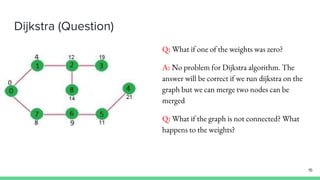



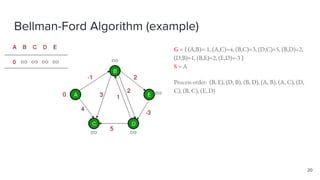







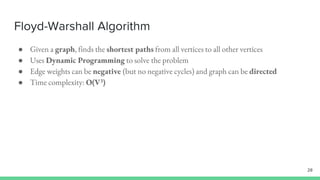

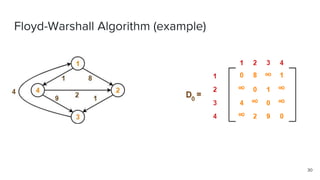











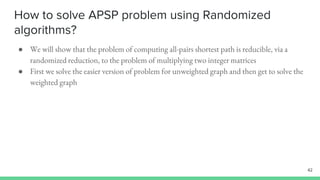
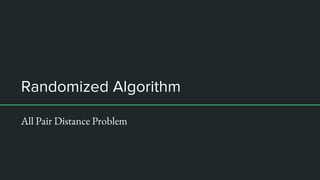

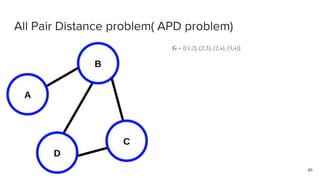
![All Pair Distance problem( APD problem)
46
G = {(1,2), (2,3), (2,4), (3,4)}
A = [[ 0, 1, 0, 0],
[ 1, 0, 1, 1],
[0, 1, 0, 1],
[0, 1, 1, 0]]](https://image.slidesharecdn.com/randomizedalgorithmsallpairsshortestpath-200517140703/85/Randomized-algorithms-all-pairs-shortest-path-46-320.jpg)
![All Pair Distance problem( APD problem)
47
G = {(1,2), (2,3), (2,4), (3,4)}
A = [[ 0, 1, 0, 0],
[ 1, 0, 1, 1],
[0, 1, 0, 1],
[0, 1, 1, 0]]
A2= [[1, 0, 1, 1],
[0, 3, 1, 1],
[1, 1, 2, 1],
[1, 1, 1, 2]]](https://image.slidesharecdn.com/randomizedalgorithmsallpairsshortestpath-200517140703/85/Randomized-algorithms-all-pairs-shortest-path-47-320.jpg)



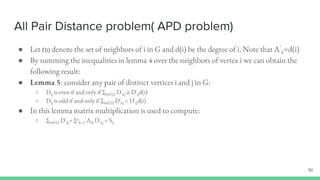




![Boolean Product Witness Matrix(BPWM)
56
G = {(1,2), (1,6), (2,3), (2,4), (2,5), (2,6), (3,4), (4,5),
(5,6)}
A =[[0, 1, 0, 0, 0, 1],
[1, 0, 1, 1, 1, 1],
[0, 1, 0, 1, 0, 0],
[0, 1, 1, 0, 1, 0],
[0, 1, 0, 1, 0, 1],
[1, 1, 0, 0, 1, 0]]
A2=[[2, 1, 1, 1, 2, 1],
[1, 5, 1, 2, 2, 2],
[1, 1, 2, 1, 2, 1],
[1, 2, 1, 3, 1, 2],
[2, 2, 2, 1, 3, 1],
[1, 2, 1, 2, 1, 3]]](https://image.slidesharecdn.com/randomizedalgorithmsallpairsshortestpath-200517140703/85/Randomized-algorithms-all-pairs-shortest-path-56-320.jpg)
![Boolean Product Witness Matrix(BPWM)
57
● If there is a unique witness for each vertex there is no problem with BPWM but if there are
many witnesses we can use some randomness
● Lemma 6: suppose an urn contains n balls of which w are white, and n-w are black.
Consider choosing r balls at random(without replacement), where n/2 ≤ wr ≤ n then:
○ PR[exactly one white ball is chosen] ≥ 1/2e](https://image.slidesharecdn.com/randomizedalgorithmsallpairsshortestpath-200517140703/85/Randomized-algorithms-all-pairs-shortest-path-57-320.jpg)



